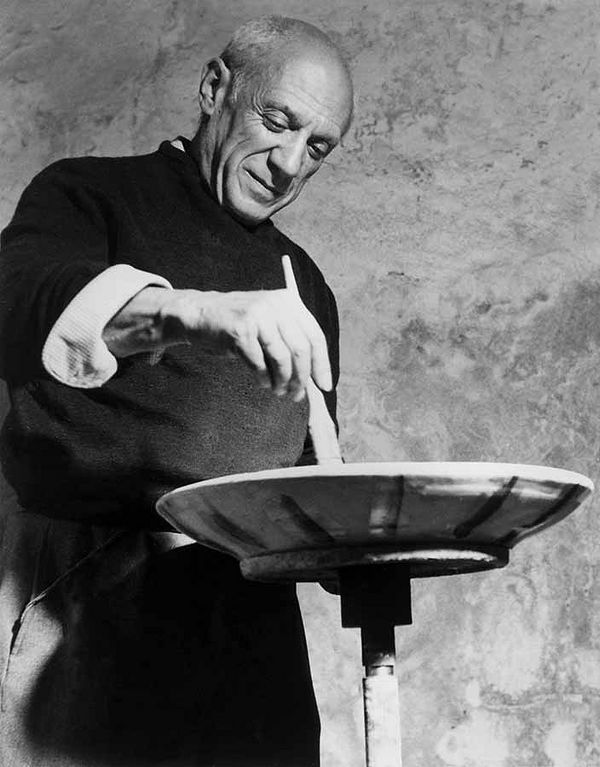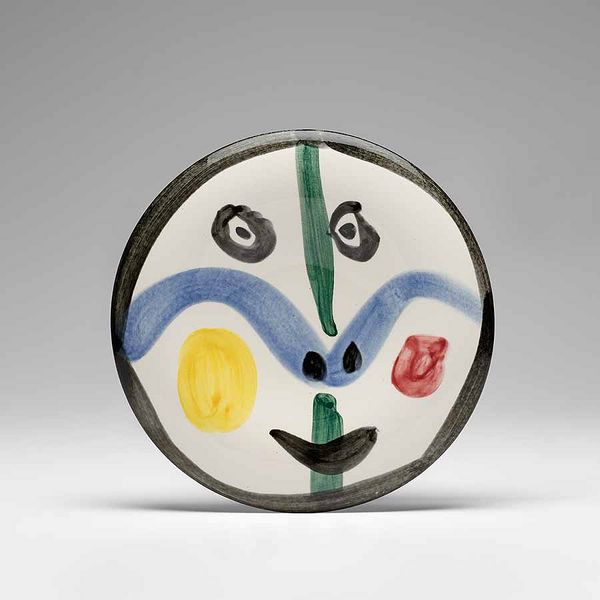Pablo Picasso, 1948. Image: akg-images / Archivio Cameraphoto Epoche.
It is in Pablo Picasso’s ceramics that we see the artist’s greatest sense of freedom through consistent experimentation. Picasso saw himself as an apprentice in his later years, and approached the medium with a renewed energy that matched the artistic fervour of his youth. Whereas a traditional ceramicist might discard results deemed unsuccessful, Picasso’s unexpected outcomes were met with surprise – and joy. Unlike paint, the artist could never predict with full certainty how the glazes and metal oxides would join, retrench, or blend, nor the exact appearance of colors before their removal from the kiln. Because of this, Picasso became enamored of working in ceramic as he was forced to embrace change more so than ever before, creating an extraordinarily challenging creative tension between artist and medium.
Picasso’s first interactions with clay coincided with an immense change and renewal within his personal life. In 1946, Picasso began a new relationship with Françoise Gilot, with whom he relocated to the South of France after holidaying in Vallauris. The small village facilitated Picasso’s introduction to Georges and Suzanne Ramié and their Madoura studio. The Ramiés shared their vast knowledge of the craft with Picasso, and this artistic camaraderie launched what would become Picasso’s twenty-five yearlong preoccupation with ceramics, producing 3,500 creations in clay between 1947 and 1971.
Making pottery was a unique experience for him [Picasso]. He became totally absorbed by it, shutting out all the disturbances of the outside world.
– Pierre Daix
Picasso’s engagement with ceramics presented a challenge to the artist who, prior to arriving in the Madoura studio, had no formal training in the discipline. Despite the obstacles of working in the new medium, Picasso tackled this new adventure with prodigious creative imagination and embraced the unpredictable nature of the kiln. He began moulding utilitarian objects such as bowls and plates through the simple yet painstaking method of replicating original objects by hand, as close to their likeness as possible.
As Picasso became more familiar with the medium, he began to develop an aesthetic poised between painting and sculpture. He would create original images in dry clay molds, before transferring the design into fresh clay. These works bear the mark ‘Empriente Originale de Picasso’ or ‘Edition Picasso’, that identifies ceramics made using a wholly new technique unique to Picasso. This invention is testament to the artist’s open embrace of experimentation, subverting traditional methods altogether and installing a personal dimension in his ceramic works.
Pablo Picasso, Visage de femme (Woman's Face) (A.R. 220), 1953. Pablo Picasso: Paper and Clay.
The continual experimentation with clay released in Picasso a great deal of liberation. Figuration emerged in exuberant faces, varying from cheerful applications of colorful glazes to fine delineations of detailed line that echo his paintings, such as the 1953 Visage de Femme. Her wavy hair is alluded to through ripples that border her curvaceous face. Adorning her décolletage is a turquoise necklace that offsets the strong horizontal nose, below which three delicate lines suggest pursed lips. Picasso drew inspiration from the women in his life, Françoise Gilot and later his final great love, Jacqueline Roque, who he met while working in the Madoura studio in 1952. The latter, whose large eyes and dark complexion are rendered in playful spirit, reflect the artist’s newfound joie de vivre in his later life.
Left to right: Pablo Picasso, Chouette femme (Wood-Owl Woman) (A.R. 119), 1951. Femme du barbu (Bearded Man's Wife) (A.R. 193), 1953. Bouteille gravée (Engraved Bottle) (A.R. 248), 1954. Pablo Picasso: Paper and Clay.
Picasso found in the playground of clay not only the challenge of a new material, but also an opportunity to work within an ancient Mediterranean tradition in a highly personable way, transposing into ceramic reality traditional methods with new application. Antiquity fused with his everyday practise, for example in the 1954 Bouteille Gravée, where we see the same stylistic lineage of archaic vocabulary revigorated into modern pottery. Picasso also consistently probed classical sources with mischievous genius, for example Ovid’s Metamorphoses (8 CE), where figures are transformed into various anthropomorphic creatures. While drawn to the allegorical potential and visual appeal of transfiguration, Picasso’s works additionally speak to the notion of transformation itself. Inconsistent shifting from one state to another – malleable to solid, clay to ceramic, animal to human – reflects the unpredictable nature of the firing process and the changes in the artist’s incidental experimentation. Moreover, the pseudo-classical approach – anecdotal as opposed to directly referential – evokes the atmosphere of an ancient time with a breadth of new life and energy. Continual conversation with classical imagery was not a retreat into antiquity, but a reassertion that objects from the past have a living presence.
Pablo Picasso, Sujet colombe (Dove Subject) (A.R. 435), 1959. Pablo Picasso: Paper and Clay.
Picasso loved birds of all shapes and sizes. They began to enter his ceramics after a serendipitous encounter with a wounded owl in 1946. The chance encounter occupied Picasso’s mind and filtered into his artistic production, as demonstrated in the charming Sujet Colombe of 1959. As with this delicate rendition, Picasso’s avian obsession became manifest in one particular form that proliferated his creative output for a succession of years: the dove. After naming his fourth daughter Paloma, the Spanish word for dove, the motif populates his ceramics while simultaneously speaking to a broader allegory of peace. Having witnessed the atrocities of war and civil unrest, Picasso adopted a pacifist mindset advocating for disarmament and reconciliation. The striking simplicity juxtaposed with inherent profundity renders the dove what was originally a personal symbol of peace a universally recognised emblem of unity.
Pablo Picasso, Visage no. 0 (Face no. 0) (A.R. 458), 1963. Pablo Picasso: Paper and Clay.
Picasso’s fervent relationship with ceramics occurred at a later juncture in his life, however the endless possibilities offered by the versatile medium lent itself perfectly to artistic experimentation. This resulted in some of the most mesmeric creations of Picasso’s oeuvre. Coinciding with a greater mood of optimism in Picasso’s life – relinquished from the atrocities of war and turbulent love affairs – this personal and artistic liberation is reflected in the warmth and light surrounding his ceramic works. Not only did Picasso find new inspiration in his later muses, he also found rejuvenation through a new medium and sense of rebirth in its age-old traditions.
Auction 6 June 2024 2pm BST
30 Berkeley Square, London, United Kingdom, W1J 6EX (map)
Viewing 31 May - 6 June
Monday-Saturday 10:00am-6:00pm
Sunday 12:00pm-6:00pm
Discover More from Editions London >
Recommended Reading
Back Again by Popular Demand >
Weaving Time: Editions London >




